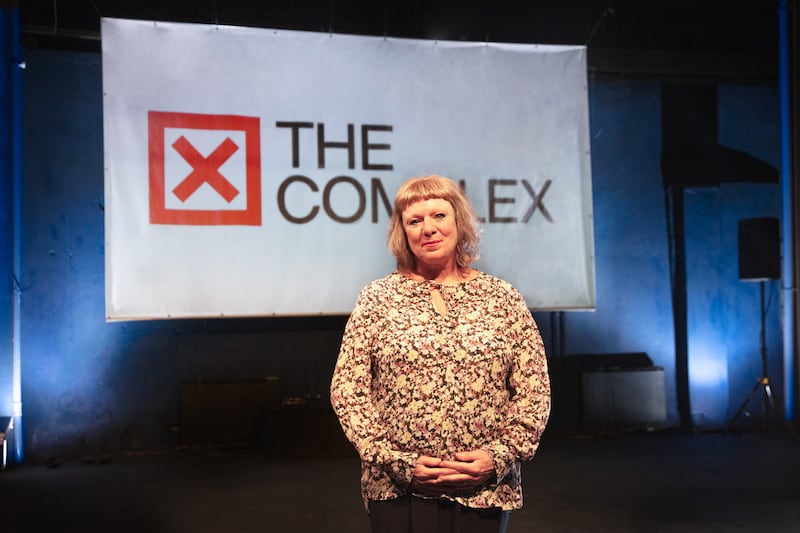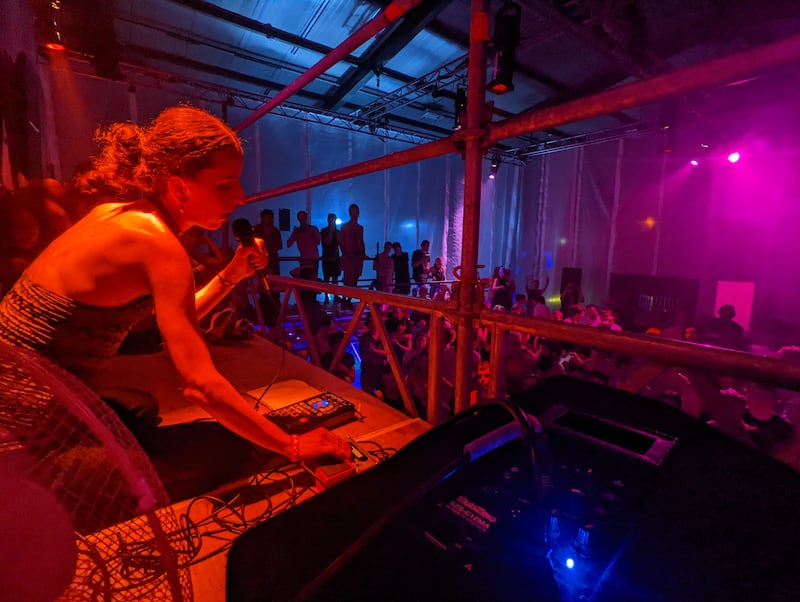There are sounds of locks becoming unsealed throughout The Complex, Dublin’s new arts centre. Inside a former fruit warehouse in Smithfield, rolling doors hum as they rise to reveal an entrance to a gallery or a loading bay.
“In the beginning, this room was filled with banana fridges,” says artistic director Vanessa Fielding, a few weeks before the venue’s official opening. After a long period of overseeing construction work, she now stands before an attractive exhibition space surrounded by enduring stone walls.
Pointing out impressive steel beams and pillars retained from the former warehouse, Fielding, who appears good-natured and patient, explains the arduous task of bringing the structure in line with building regulations. “The biggest obstacle was achieving compliance on a budget that wouldn’t stretch. We had aspirations for repurposing things but you have to build it like it’s a new building,” she says.
The result of that endeavour is an arts space unlike any other in Dublin. In the back of the building, a long row of 16 artist studios extends the length of a gigantic hall, where a soundproof mezzanine is used by alternative broadcasters Dublin Digital Radio. Upstairs, a smaller storeroom that originally went undiscovered is being fitted out for performance and has been named The Cooler.
I may very well have ignored the call to home if I hadn’t been robbed at knifepoint in Brazil
‘Where I come from, people don’t do medicine. It’s not on your radar’: how a new generation of GPs is being trained
Despite earning €100,000 a year, buying a one-bed apartment in Dublin still seems an impossible dream
Ken Early: Legendary Messi continues to keep the ravages of time at bay
Fielding and her team drew on the neighbourhood’s fruit and flower industry as the venue’s theme. For instance, the largest auditorium – a magnificently high-ceilinged expanse of blue-painted brick – is named The Depot. She shows me photographs of different events held there in recent months, all revealing a new configuration of the space.
Transformable fixtures
Images show a rapturous concert by post-punk stars Fontaines DC, filling the room with a standing audience, as towering strobes of light flank a stage. For an awards ceremony organised by a design college, tiered seating is neatly arranged to fit a 350-person capacity. A once-off club night by nightclub creatives Temporary Pleasure built raised platforms for dancing. “The Depot transforms. That’s what people say all the time,” says Fielding.
She thinks a large part of the appeal is the location, the promise of finding an arts centre in a market district. That wouldn’t have always been the case. In the 1990s, Fielding persuaded the owners of a vacant property on Middle Abbey Street to sell – an attempt to seize it as an art space but nothing came of it. “The developers said nobody will ever come to the north side. It’s not even worth discussing,” she says. The Gate Theatre and the Abbey Theatre were satellites in their own orbits, while Dublin City Council’s attention was fixated on developing the Temple Bar Cultural Quarter on the opposite side of the river.

By then, she had a series of notable successes as a theatre director in London. There was an imaginative play version of Simone de Beauvoir’s novella The Woman Destroyed, adapted and starring Diana Quick, at the Lyric Hammersmith. She was assistant director on a landmark production of the Ibsen classic An Enemy of the People, featuring Tom Wilkinson, and staged in the round at the Young Vic. Since arriving in Ireland, she had staged the gruesome musical Little Shop of Horrors for the Lyric Theatre, and Patrick Hamilton’s Victorian-set thriller Gas Light for Druid.
Her story serves as a reminder of Irish nationalism in the live performance industry, at a time when productions like Dancing at Lughnasa and Riverdance made gainful transfers abroad: “It wasn’t a great time to be a director who grew up and had a career in England. The directors of the Abbey and the Gate were upfront with me and said it’s unlikely we’re going to employ you because you’re not a star international director, and you’re not Irish.
“I decided I’ll create something new,” she says, with a smile.
Medium of theatre
Then in her late 20s, she followed her own feelings on mainstream theatre, which she thought didn’t connect well with people her own age. (Nowadays, she thinks a lot about her children, and what would excite them as art-goers: “I think they would want to be immersed in something, so they can be near it.”) Her career pivoted into a new direction where she converted unused buildings – an empty distillery warehouse or retail unit – into venues for performance, as if the medium of theatre could be rediscovered in new spaces, again and again.
This isn’t the first version of The Complex. In 2009, Fielding was given control of an empty unit on Smithfield Square by the property developer Chris Kelly. She had previously designed a different scheme with another developer, paired together by Dublin City Council, but that didn’t come to fruition. How does a director of plays become a venue-builder and get involved in property negotiations?
“Perhaps my experience as a director helped. I had to direct lots of older actors when I was young, and I had to find a way to communicate with them. Maybe that’s the skill I carried into it,” she says.
Securing a lease, she realised, depended on mutual exchange. When the Smithfield site got bought by the National Asset Management Agency, leaving The Complex without a home, Fielding made an attractive offer to a judge who owned two vacant shop units on Benburb Street. “An owner would have to pay rates on a vacant property, but as a registered charity we don’t pay any rates. In managing the building for community use, we would negate their rates,” she says.
From there, The Complex moved into the labyrinthine settings of the former Keelings fruit market on Little Green Street. Then, only four years into its 10-year lease, it was bought out. The building has since been demolished and replaced by a StayCity aparthotel.
That outcome is grimly familiar. It’s usually during economic downturns when managers acquire keys to new venues. Recently, the last of the independent theatre infrastructure founded during the recession of the 1980s seemed to vanish with the razing of the Tivoli Theatre. Fielding is among the entrepreneurs who created new spaces during this century’s recession, but those other venues – Block T’s Smithfield premises, South Studios, Theatre Upstairs and Chancery Lane Theatre – have all disappeared. A city in thrall to unwise development, and that squeezes out space for culture, seems too hostile for an arts venue to survive.
Labour of love
That makes Fielding’s achievement feel near-impossible. She credits Brendan Kenny, former deputy chief executive of Dublin City Council, as an essential supporter. A lot of the labour, however, was a volunteer effort. “We did a build costing €1.8 million for €650,000. That’s just hard graft. In any other capital city, they’d think ‘how did they do that?’
“I think the volunteers could see we viewed it as bigger than ourselves, and that it was something offering opportunities in an area that doesn’t have a lot of arts infrastructure,” she says.

Since its return, The Complex has already resembled a haven for the city’s artists. It recently hosted OverTheTop Wrestling, whose matches used to take place at the Tivoli Theatre. Dublin Digital Radio was previously based at the alternative venue Jigsaw, now also gone. If that sounds like a broad range of artistic mediums, that’s because Fielding’s vision for the arts centre is grand in scale and unhemmed by categorisation. “We span all the disciplines. We set ourselves apart because most venues can only do one or two of them. We can do all of them,” she says.
When it comes to the future of Dublin’s cultural infrastructure, nothing is certain. Fielding already has the end of her lease in 2025 on the horizon, and is putting a plan together to buy the building. She mentions the heartening example of the music ensemble Kirkos, who rented a studio in The Complex before opening the venue Unit 44 in Stoneybatter. If new independent spaces are to prosper, she thinks they should be artist-led.
Indeed, The Complex’s auditoriums – capable of searching, enthralling transformations – could be seen as an extension of her own artistry. Fielding says that when she lived in London, she found that city too vast to forge connections. She came to Dublin, a director preferring forms of theatre that unify people: the close proximity of in-the-round productions.
“My own techniques were leading me to a more immersive kind of theatre, which eventually brought me to a city which, I felt, had a binding community in it.” It’s as if a city, like art, is something that can feel intimate.












